SNOQUALMIE PASS, Wash. — On Wednesday, the Northwest Avalanche Center had some backcountry mountain areas, like Mount Baker and Stevens Pass, under an avalanche warning, and other areas, like Snoqualmie Pass, were designated to have high avalanche danger.
Crews at the Summit at Snoqualmie had been working for two days to mitigate the risk of avalanches.
“Alpental is very steep and rugged,” said Rob Gibson, who has worked for 40 years in patrol and safety at the Summit at Snoqualmie. “So, it really needs to have regular checkups, patrols always out accessing danger, and then when we get significant snow, they have to do some mitigation work.”
He said they use a variety of strategies, including explosives, to mitigate avalanches, but Gibson said skiers and snowboarders should take their own precautions, too, when it comes to avalanche safety.
“We can't get rid of the risk 100%. So, it's really important that people recognize that,” said Gibson. “We always recommend you ski with a partner. We always recommend you have avalanche tools for rescue because if your partner doesn't rescue you, it gets less likely that you could survive an event like that.”
Gibson also said it is essential that people follow the rules of the mountain. He said one problem is people who duck under ropes of areas that are closed off. He said they are closed off for a reason, and this puts not only that person but also the ski patrol in danger.
“Ducking ropes, what they call poaching, it's truly a dangerous situation and it even puts the avalanche workers in danger,” said Gibson.
Gibson said people should educate themselves on deep snow safety and said the Northwest Avalanche Center is a good resource.
“Locations where we have a warning now, we really want folks to think about avalanches that can run long distances and connect to places that you might not usually associate with avalanche terrain,” said Dennis D’Amico, who is the forecast director and avalanche meteorologist for the Northwest Avalanche Center.
D’Amico said people should avoid avalanche terrain on Wednesday and said that in the following days, people still need to be cautious.
“It’s going to be a little bit more nuanced, but there's still going to be dangerous avalanche conditions,” said D’Amico. “So, it requires a more conservative approach.”
D’Amico said to always have a beacon, probe, and shovel in the backcountry, and even an airbag in some situations.
“Nothing guarantees you a safe outcome when it comes to avalanches, but really, it's about communication with your partners, setting clear objectives, and knowing when it's time to turn around when you see something that is unexpected or what we would consider a red flag for avalanche danger,” said D’Amico.

